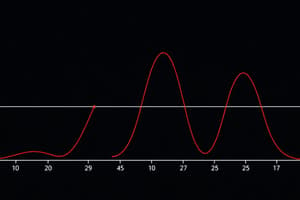Podcast
Questions and Answers
What are the three requirements that enter into the design of a control system?
What are the three requirements that enter into the design of a control system?
- Transient response, frequency response, and error analysis
- Steady-state response, stability, and error analysis
- Stability, error analysis, and natural response
- Transient response, stability, and steady-state errors (correct)
In what section of the text are definitions of stability, instability, and marginal stability presented?
In what section of the text are definitions of stability, instability, and marginal stability presented?
- Section 1.3
- Section 1.2
- Section 1.8
- Section 1.5 (correct)
What is the definition of stability for a linear, time-invariant system?
What is the definition of stability for a linear, time-invariant system?
- The forced response grows without bound as time approaches infinity
- The natural response approaches zero as time approaches infinity (correct)
- The forced response approaches zero as time approaches infinity
- The natural response grows without bound as time approaches infinity
What happens if a system is unstable?
What happens if a system is unstable?
What is the sum of the forced and natural responses in a system's total response?
What is the sum of the forced and natural responses in a system's total response?
What does the Routh-Hurwitz criterion help determine?
What does the Routh-Hurwitz criterion help determine?
In a linear, time-invariant system, what indicates system instability?
In a linear, time-invariant system, what indicates system instability?
What is the relationship between sign changes in the Routh table and the roots of an even polynomial?
What is the relationship between sign changes in the Routh table and the roots of an even polynomial?
What does the state-space representation of a system help determine?
What does the state-space representation of a system help determine?
When is a system marginally stable based on the location of its poles?
When is a system marginally stable based on the location of its poles?
According to the Routh-Hurwitz Criterion, what does an entire row of zeros in the Routh table indicate?
According to the Routh-Hurwitz Criterion, what does an entire row of zeros in the Routh table indicate?
What does the number of sign changes in the first column of the Routh table indicate?
What does the number of sign changes in the first column of the Routh table indicate?
What does the Routh-Hurwitz Criterion provide without solving for closed-loop system poles?
What does the Routh-Hurwitz Criterion provide without solving for closed-loop system poles?
How are Routh table entries calculated?
How are Routh table entries calculated?
What does an epsilon (ε) replace in the first column of the Routh table?
What does an epsilon (ε) replace in the first column of the Routh table?
What is the BIBO definition of stability for a linear, time-invariant system?
What is the BIBO definition of stability for a linear, time-invariant system?
What is the alternate definition for instability based on the total response of a linear, time-invariant system?
What is the alternate definition for instability based on the total response of a linear, time-invariant system?
What is the condition for a linear, time-invariant system to be marginally stable based on the natural response?
What is the condition for a linear, time-invariant system to be marginally stable based on the natural response?
How are stable systems characterized in terms of the location of their poles?
How are stable systems characterized in terms of the location of their poles?
What makes it difficult to determine if a feedback control system is stable?
What makes it difficult to determine if a feedback control system is stable?
According to the natural response definitions of stability, a system is unstable if:
According to the natural response definitions of stability, a system is unstable if:
What characterizes an unstable system according to the BIBO definitions of stability?
What characterizes an unstable system according to the BIBO definitions of stability?
What type of natural responses yield stable systems?
What type of natural responses yield stable systems?
What is the alternate definition of instability based on the total response?
What is the alternate definition of instability based on the total response?
What is the implication of poles in the right half-plane of the s-plane for system stability?
What is the implication of poles in the right half-plane of the s-plane for system stability?
Flashcards are hidden until you start studying
Study Notes
Routh-Hurwitz Criterion for Stability
- Closed-loop transfer function with only left-half-plane poles implies all coefficients of the denominator are positive
- Unstable system if all coefficients of the denominator have different signs
- Routh-Hurwitz criterion provides stability information without solving for closed-loop system poles
- The method generates a Routh table and interprets it to identify the number of closed-loop system poles in different sections of the s-plane
- The criterion's power lies in design rather than analysis, providing closed-form expressions for stability ranges
- Routh table entries calculated using negative determinants of previous rows
- Number of roots in the right half-plane equals the number of sign changes in the first column
- An epsilon (ε) replaces zero in the first column to avoid division by zero
- Entire row of zeros in the Routh table indicates the presence of a purely even polynomial factor with symmetrical roots about the origin
- The row previous to the row of zeros contains the even polynomial factor
- Polynomials generating entire rows of zeros have roots symmetrical about the origin and apply only to the even polynomial
- Routh table provides information about the existence and characteristics of even polynomials with symmetrical roots
Defining Stability and Instability in Linear, Time-Invariant Systems
- A linear, time-invariant system is marginally stable if the natural response neither decays nor grows but remains constant or oscillates as time approaches infinity.
- Stability implies that as the natural response approaches zero, only the forced response remains.
- The BIBO definition of stability states that a system is stable if every bounded input yields a bounded output.
- An alternate definition for instability based on the total response states that a system is unstable if any bounded input yields an unbounded output.
- Marginally stable systems, by the natural response definitions, are included as unstable systems under the BIBO definitions.
- Unstable systems, whose natural response grows without bound, can cause damage to the system, adjacent property, or human life.
- The natural response definitions of stability rely on the location of system poles in the left or right half-plane of the s-plane.
- Stable systems have closed-loop transfer functions with poles only in the left half-plane, while unstable systems have poles in the right half-plane or poles of multiplicity greater than 1 on the imaginary axis.
- Marginally stable systems have closed-loop transfer functions with only imaginary axis poles of multiplicity 1 and poles in the left half-plane.
- It is not always easy to determine if a feedback control system is stable due to the complexity of locating the poles of the equivalent closed-loop system without factoring or solving for the roots.
- The text provides insight into how to define, determine, and understand stability and instability in linear, time-invariant systems.
- The definitions presented are crucial for understanding the behavior and implications of stability and instability in systems.
Studying That Suits You
Use AI to generate personalized quizzes and flashcards to suit your learning preferences.





